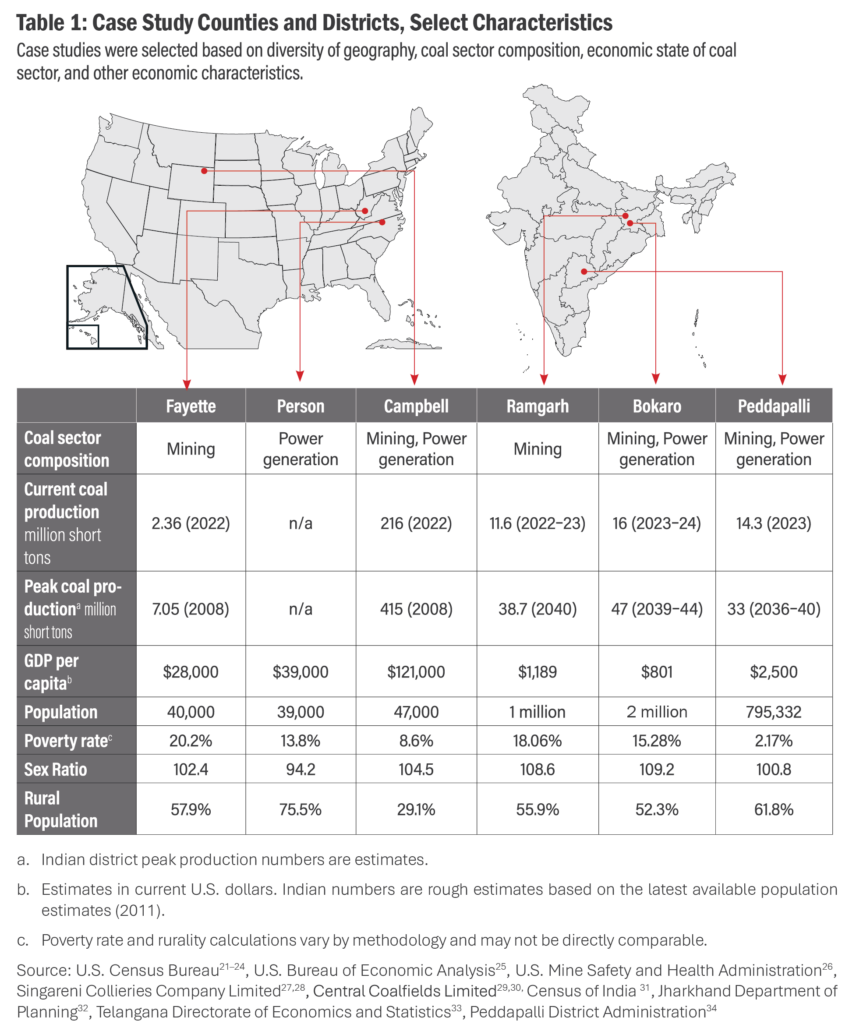Economic Diversification of Coal Communities: Case Studies from the U.S. and India
Ian Barlow, Sandeep Pai, Rishi Kishore, Deeksha Pande | September 2024
[Click to read the full report]
Executive Summary
Coal production and consumption are under pressure worldwide. This pressure is largely due to the need to address climate change, or concerns about coal’s economic viability, or both. In the United States, coal production has fallen by 47% since 2001 owing in large part to competition from natural gas and renewables.1 In India, a commitment to coal phase-down has been made, but its production and consumption continue to grow rapidly to meet development needs—conservative estimates put annual coal production at 1.3 billion tons by 2030, i.e. a 300 million ton increase in current production levels.2
Addressing climate change successfully may require shuttering hundreds of coal mines and power plants globally, affecting coal-reliant communities on an unprecedented scale. For these communities, managing the sector’s decline is an enormous—and often existential—undertaking.
To address this challenge, policymakers and scholars worldwide have proposed and enacted frameworks and mechanisms for a ‘just transition’ of coal-reliant communities, to mitigate the economic losses of coal decline. Diversification of coal-dependent economies is a goal often included in these just transition proposals meant to reduce coal dependencies and create more local economic resilience.
Economic diversification is generally enabled through economic development, which includes activities ranging from redeveloping legacy infrastructure for prospective investments to increasing literacy for local workforce readiness. These activities can both help attract new sectors to a community and expand smaller pre-existing ones.
Focusing on three local regions (counties/districts) each in the United States and India, we conducted a mixed-methods study to understand the scale and type of coal dependencies in these local regions, and economic diversification options for the future.

Based on the study, we have several recommendations for advancing just transition understanding and policy work:
1. Governments, philanthropies, academia, international organizations, and civil society need to holistically consider coal dependencies when navigating just transition. How the coal sector is integrated in communities varies substantially. These dependencies differ spatially, by degree, and by type. While all case studies show a dependence on the coal industry for employment and government revenues, the degree of dependence for either varies considerably. Other dependencies also vary; for example, in India informal coal jobs are prominent in some communities, but this is not the case in the United States. Holistic consideration of the coal industry’s role in these communities can help foster more robust transition planning and management that account for essential, though perhaps less obvious, impacts.
2.Governments, philanthropies, academia, international organizations, and civil society should support long-term economic diversification beyond the energy sector. Coal decline in coal-reliant communities is experienced acutely as an economic issue. Non-energy sector alternatives to coal may prove as or more beneficial to these communities, leading to a local economic future beyond or separate from energy. Funders should foster activities beyond greenhouse gas emissions mitigation in communities transitioning away from coal. Transition funding should support broader economic development activities that can help these communities diversify beyond clean energy deployment and repurposing of fossil fuel assets for alternative uses within the energy sector.
3. Governments, philanthropies, IGOs, and other funders should increase longer-term funding opportunities for development activities that foster diversification. Strategies can take a decade or more to bear fruit, thus making stable funding a huge boon to diversification efforts. Funding should not only be made available for clean energy projects. Our analysis shows that communities across the United States and India aspire to diversify into sectors ranging from tourism to food products. Activities destined to help coal-reliant communities should involve programming or funding that is guaranteed over longer periods, in order to help foster stability in the community’s transition efforts.
4. More research is needed by academia, state governments, IGOs, philanthropic organizations, and other stakeholders into finding suitable transition sectors for coal communities. Interviewees and discussants identified sectors in each case study—from pisciculture to data centers—based on local assets, existing sectors, or government incentives; however, whether these sectors can fill the socio-economic gaps left by coal decline is not well understood. More research is needed to determine which sectors would be best suited for coal communities both in terms of filling the gaps left by coal decline, a community’s unique characteristics, and its local assets. Additionally, research should be conducted into balancing sector-specific development efforts with broader economic development activities, given limited resources and to avoid risks of unduly targeting specific sectors.
5. State and national governments should help localities holistically define, track, and assess economic diversification at the local level. There is no universal definition for diversification at the local level. Providing a data-driven, multivariate definition and evaluation of diversification would help communities and external supporters chart a path toward economic diversification at the local level.